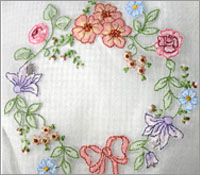The Technique of Shadow Work
 As originally developed, shadow work is a hand sewing technique that is intended for slightly opaque but somewhat sheer fabrics.
As originally developed, shadow work is a hand sewing technique that is intended for slightly opaque but somewhat sheer fabrics.Examples include cotton batiste, most linens, organdy, chiffon, fine lightweight wool, lightweight cotton muslins, voile, silk, and organza.
To make a shadow design, let’s imagine you draw a small circle onto a piece of fabric. You thread a needle with a blue thread and bring your needle from behind the fabric and through it on a part of the outline of the circle.
You’d take a tiny straight stitch bringing the needle back under the fabric, then underneath the fabric you would cross over to the opposite side of the circle and bring your needle back up through the fabric.
You’d take a tiny straight stitch again bringing your needle beneath the fabric once more, cross over to where you first began your first stitch and come up through one of the holes of that tiny stitch and take another stitch, bring the needle back down and again cross over to take your next stitch, etc.
Once you have gone all around that circle with the straight stitch, the blue threads will have crisscrossed behind the fabric thus creating a “field” of blue. This blue fill area when viewed from the top of the fabric creates a shadow effect of softly muted blue with an outline of straight stitches around it. Hence the name “shadow work.”
After years of studying hand-done shadow work and techniques, Suzanne Hinshaw, a well-known educator and digitizer in the home embroidery market, came up with her own method of replicating the same look using her single-needle home embroidery machine. (This method also can be done with the multi-needle commercial machines as well.) Using specialized digitizing techniques that she developed, she was able to create a hand-sewn look for use on baby clothes, dresses, pillows, handkerchiefs, napkins, blouses, and much more.
According to Hinshaw, using the machine instead of hand sewing actually expands the number of things that can be done with shadow work. “The hand needle can do only so much,” she says. “If I want a circle to be shadowed from the outside edges toward the center, I can’t do that with a hand needle. With machine shadow work, I can stitch a green leaf as the base and then put in a darker green on top of the lighter green. Then when I put my fabric down and it stitches the outline all the way around, it shadows through with shading. So machine shadow work can look like it’s hand painted.”
In addition to layering colors, you also have more palettes of color to work with, notes Hinshaw. So you can get a more detailed version of shadow work than you could ever do by hand. “This is done by using a variety of threads and incorporating “shading” factors into the designs. This is what can give a flower a three-dimensional appearance,” she says.
“This shading creates depth that filters through the fabric as well as roundness and softness,” she continues. “By changing out the colors of the shading, the same flower can almost appear as though it’s entirely different. Add a touch of metallic thread to that design and what was once stitched for a baby garment can become a design used for a festive holiday or cocktail dress.”
Once Hinshaw fine tuned her shadow work machine techniques, she began digitizing design collections that she now offers for sale.
There are five collections available and Hinshaw is constantly adding new designs throughout the year. Each design is digitized manually, and Hinshaw estimates that a single design takes approximately 40 hours to complete. “I put in every stitch by hand,” she says. “I do all my own artwork, digitizing, and sewouts and it takes a lot of time,” she says. | Embroidery | Embroidery designs | Embroidered clothing | zardosi embroidery | Kutch embroidery | kantha embroidery |


0 Comments:
Post a Comment
<< Home